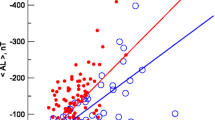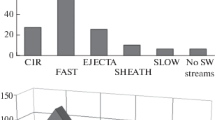Abstract
On July 22, 2004, the WIND spacecraft detected a typical interplanetary shock. There was sustaining weak southward magnetic field in the preshock region and the southward field was suddenly enhanced across the shock front (i.e., southward turning). When the shock impinged on the magnetosphere, the magnetospheric plasma convection was abruptly enhanced in the central plasma sheet, which was directly observed by both the TC-1 and Cluster spacecraft located in different regions. Simultaneously, the Cluster spacecraft observed that the dawn-to-dusk electric field was abruptly enhanced. The variations of the magnetic field observed by TC-1, Cluster, GOES-10 and GOES-12 that were distributed in different regions in the plasma sheet and at the geosynchronous orbit are obviously distinct. TC-1 observations showed that the magnetic intensity kept almost unchanged and the elevation angle decreased, but the Cluster spacecraft, which was also in the plasma sheet and was further from the equator, observed that the magnetic field was obviously enhanced. Simultaneously, GOES-12 located near the midnight observed that the magnetic intensity sharply increased and the elevation angle decreased, but GOES-10 located in the dawn side observed that the magnetic field was merely compressed with its three components all sharply increasing. Furthermore, the energetic proton and electron fluxes at nearly all channels observed by five LANL satellites located at different magnetic local times (MLTs) all showed impulsive enhancements due to the compression of the shock. The responses of the energetic particles were much evident on the dayside than those on the nightside. Especially the responses near the midnight were rather weak. In this paper, the possible reasonable physical explanation to above observations is also discussed. All the shock-induced responses are the joint effects of the solar wind dynamic pressure pulse and the magnetic field southward turning.
Similar content being viewed by others
References
Xiong M, Zhong P, Hu Y Q, et al. Response of the Earth’s magnetosphere and ionosphere to solar wind driver and ionosphere load: Results of global MHD simulations. Chinese Phys Lett, 2009, 26: 015202
Liou K, Newell P T, Meng C I, et al. On the relationship between shock-induced polar magnetic bays and solar wind parameters. J Geophys Res, 2004, 109: 6306
Lee D Y, Lyons L R. Geosynchronous magnetic field response to solar wind dynamic pressure pulse. J Geophys Res, 2004, 109: 4201
Nakai H, Kamide Y, Russell C T. Influences of solar wind parameters and geomagnetic activity on the tail lobe magnetic field: a statistical study. J Geophys Res, 1991, 96: 5511–5523
Kawano H, Yamamoto T, Kokubun S, et al. Rotational polarities of sudden impulses in the magnetotail lobe. J Geophys Res, 1992, 97: 17177–17182
Fairfield D H, Jones J. Variability of the tail lobe field strength. J Geophys Res, 1996, 101: 7785–7792
Collier M R, Slavin J A, Lepping R P, et al. Multispacecraft observations of sudden impulses in the magnetotail caused by solar wind pressure discontinuities: Wind and IMP 8. J Geophys Res, 1998, 103: 17293–17306
Lee D Y, Lyons L R, Reeves G D. Comparison of geosynchronous energetic particle flux responses to solar wind dynamic pressure enhancements and substorms. J Geophys Res, 2005, 110: 9213
Keika K, Nakamura R, Baumjohann W, et al. Response of the inner magnetosphere and the plasma sheet to a sudden impulse. J Geophys Res, 2008, 113: A07S35
Liu Z X, Escoubet C P, Pu Z Y, et al. The Double Star mission. Ann Geophys, 2005, 23: 2707–2712
Lu Q M, Hu Q, Zank G P, The interaction between Alfven waves and perpendicular shocks. In: AIP Proceedings, Particle Acceleration and Transport in the Heliosphere and Beyond, 2008, 321–326
Wang S, Lu Q M, The simulation of collisionless shock in space (in Chinese). Prog Astron, 1997, 15: 218–230
Xiong M, Zheng H N, Wu S T, et al. Magnetohydrodynamic simulation of the interaction between two interplanetary magnetic clouds and its consequent geoeffectiveness. J Geophys Res, 2007, 112: A11103
Xiong M, Zheng H N, Wang Y M, et al. A numerical simulation on the solar-terrestrial transit time of successive CMEs during November 4–5, 1998. Chin J Geophys, 2005, 48: 805–813
Russell C T, Ginskey M, Petrinec S M. Sudden impulses at low-latitude stations: Steady state response for northward interplanetary magnetic field. J Geophys Res, 1994, 99: 253–261
Rufenach C L, Schaper J, McPherron R L. The quiet geomagnetic field at geosynchronous orbit and its dependence on solar wind dynamic pressure. J Geophys Res, 1992, 97: 25–42
Sanny J, Tapia J A, Sibeck D G, et al. Quiet time variability of the geosynchronous magnetic field and its response to the solar wind. J Geophys Res, 2002, 107: 1443
Wing S, Sibeck D G, Wiltberger M, et al. Geosynchronous magnetic field temporal response to solar wind and IMF variations. J Geophys Res, 2002, 107: 1222
Zesta E, Singer H J, Lummerzheim D, et al. The effect of the January 10, 1997, pressure pulse on the magnetosphere-ionosphere current system. In: Geophysical Monograph 118, Magnetospheric Current Systems. Washington D C: AGU, 2000. 217
Chua D, Parks G, Brittnacher M, et al. Energy characteristics of auroral electron precipitation: A comparison of substorms and pressure pulse related auroral activity. J Geophys Res, 2001, 106: 5945–5956
Boudouridis A, Zesta E, Lyons R, et al. Effect of solar wind pressure pulses on the size and strength of the auroral oval. J Geophys Res, 2003, 108: 8012
Lyons L R, Lee D Y, Wang C P, et al. Global auroral responses to abrupt solar wind changes: Dynamic pressure, substorm, and null events. J Geophys Res, 2005, 110: 8208
Lukianova R. Magnetospheric response to sudden changes in solar wind dynamic pressure inferred from polar cap index. J Geophys Res, 2003, 108: 1428
Lee D Y, Lyons L R, Yumoto K. Sawtooth oscillations directly driven by solar wind dynamic pressure enhancements. J Geophys Res, 2004, 109: 4202
Lyons L R. A new theory for magnetospheric substorms. J Geophys Res, 1995, 100: 19069–19082
Chen M W, Schulz M, Lyons L R, et al. Storm time transport of ring current and radiation belt ions. J Geophys Res, 1993, 98(A3): 3835–3849
Araki T. A physical model of the geomagnetic sudden commencement in solar wind sources of magnetospheric ultra-low-frequency waves. In: Geophys Monogr Set, Vol 81. Washington D C: AGU, 1994. 183–200
Fu X R, Lu Q M, Wang S. The process of electron acceleration during collisionless magnetic reconnection. Phys Plasmas, 2006, 13: 012309
Lu Q M, Li X. Heating of ions by low-frequency Alfven waves. Phys Plasmas, 2007, 14: 042303
Xiao F L, Zhou Q H, He H Y, et al. Electromagnetic ion cyclotron waves instability threshold condition of suprathermal protons by kappa distribution. J Geophys Res, 2007, 112: A07219
Xiao F L, Zhou Q H, Zheng H N, et al. Whistler instability threshold condition of energetic electrons by Kappa distribution in space plasma. J Geophys Res, 2006, 111: A08208
Author information
Authors and Affiliations
Corresponding author
Additional information
Supported by the National Natural Science Foundation of China (Grant Nos. 40731054, 40804046, 40704031 and 40704027) and Specialized Research Fund for State Key Laboratories
About this article
Cite this article
Yao, L., Liu, Z., Zuo, P. et al. Responses of properties in the plasma sheet and at the geosynchronous orbit to interplanetary shock. Chin. Sci. Bull. 54, 3308–3317 (2009). https://doi.org/10.1007/s11434-009-0213-4
Received:
Accepted:
Published:
Issue Date:
DOI: https://doi.org/10.1007/s11434-009-0213-4




